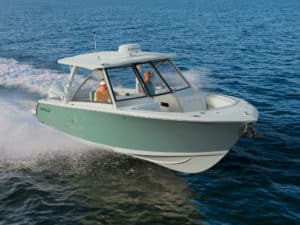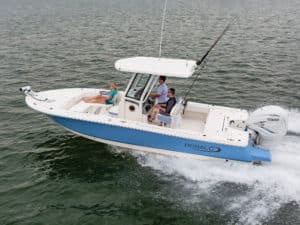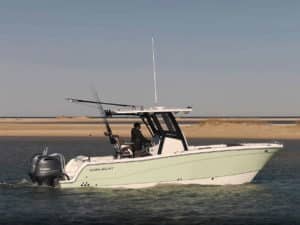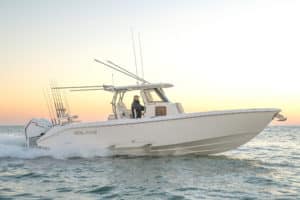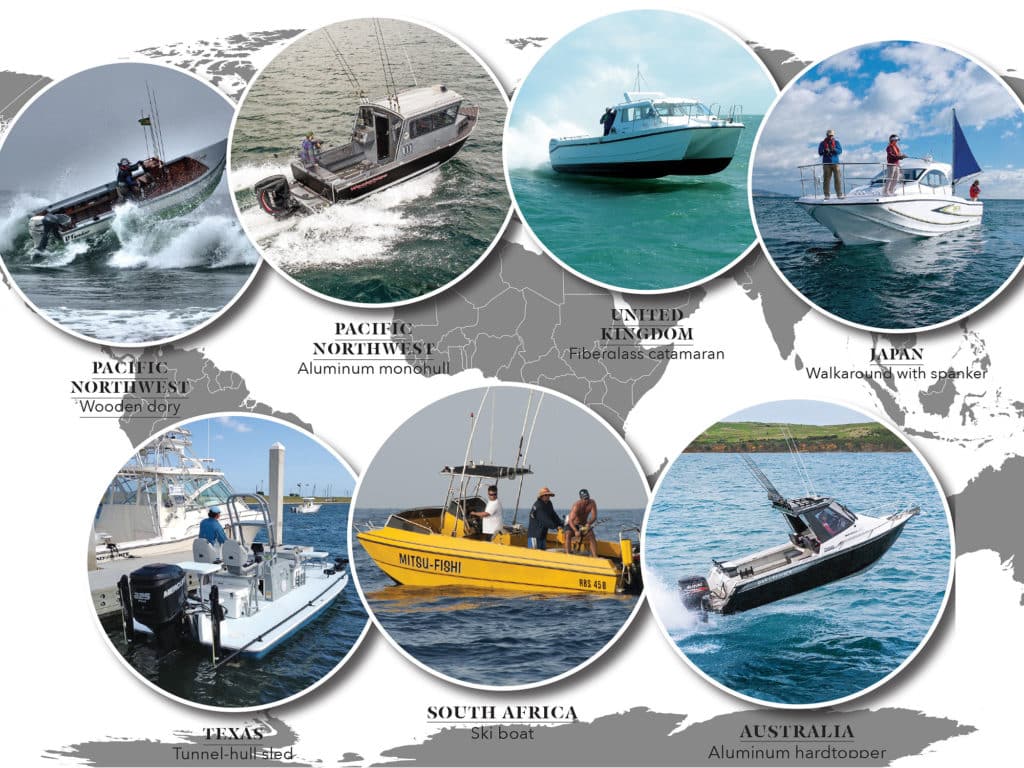
“A fishing boat with a sail? And you call that sail a ‘spanker?’”
My phone conversation with Yamaha’s Jeff Hudson and Ritsu Kadota just turned wildly interesting. I know that anglers around the world board a variety of purpose-built platforms to fish offshore and nearshore, but Yamaha’s walkaround-boat designs — unique to Japan and some with a small sail aft — caught me off-guard.
Ditto the dory. The more I read about Pacific City, Oregon’s iconic dory fishing boats, the more my imagination churned. Pacific City guards the 115-year tradition of dories, which anglers launch off the beach into sometimes-enormous coastal swells.
Fishing and boating, like all things cultural, can vary across states and continents. Recreational anglers in the fishing-centric Southeast United States (like me) prefer a fiberglass center console. But we here do not deal with frigid water temperatures, rocky coastlines, or trailering and launch issues.
To explore some of our global nautical diversity, I queried Sport Fishing contributors and friends, and boatbuilders from around the globe. Here’s just a glimpse of what the rest of the world — and some select portions of our country — call a “fishing boat.”
Japanese Walkarounds
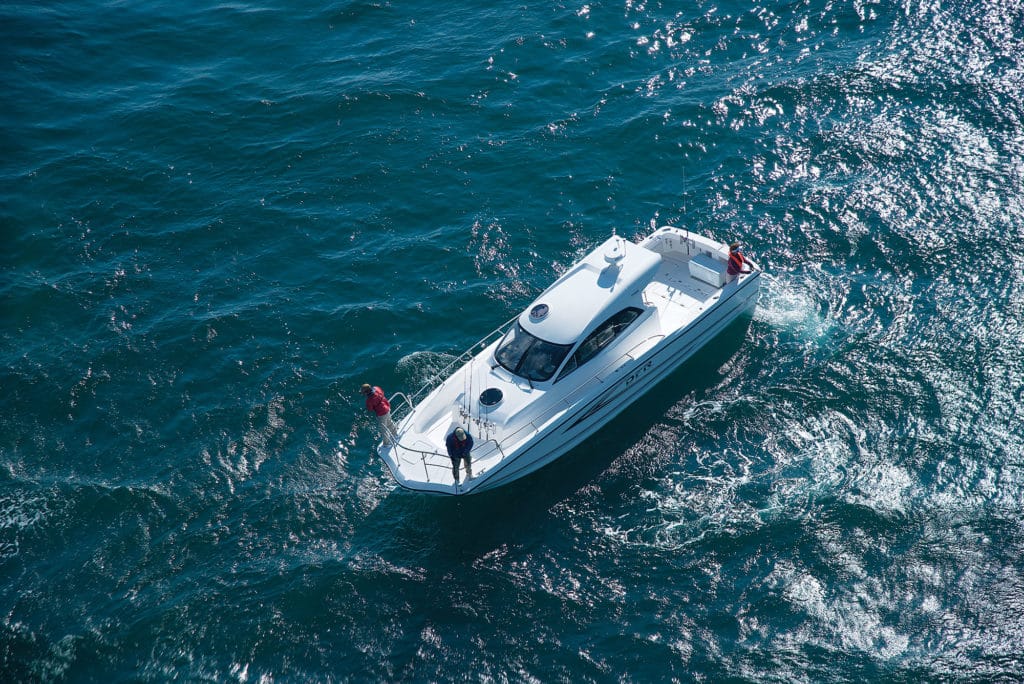
“Fishing is at the heart of a Japanese person. They live for the salt water,” says Yamaha’s Hudson, the division manager for marine product development who spends a good deal of time in Japan. “The boat designs are quite different. Cabins are really popular. The boats have a high bow rail, and most of the rod holders are up front in the bow.”
Japanese small-boat fishermen use mostly lures and plugs to cast while drifting. Yamaha’s DFR (diesel fishing revolution) walkarounds feature a jutting, squarish foredeck that extends beyond the forepeak. The high bow rail gives anglers a handhold or a leaning post in rough seas.
The average boating angler owns a 20- to 30-foot cabin/pilothouse boat; larger vessels come with inboard power, and smaller ones carry outboards. Yamaha also makes a smaller bay boat with a single outboard as well as larger sport-fishing convertibles and expresses for the country’s burgeoning recreational marlin fishery.
Spanker Sail
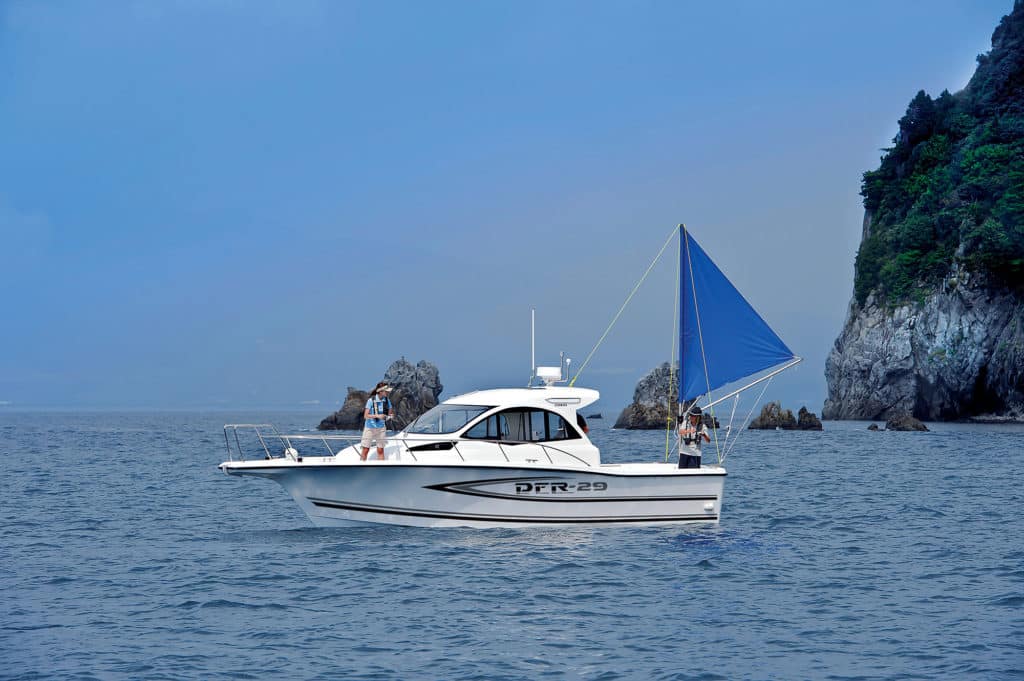
The aft sail — or spanker — available on some models helps Japanese fishermen hold position over a fishing spot, Hudson says. “Instead of just drifting, the boat turns on center. The spanker pivots everything on the center of gravity of the boat.”
The spanker is used in conjunction with the electronic throttle-and-shift, bumping in and out of gear, to create a virtual-anchor effect. The boat hovers despite wind and current. Because anglers usually fish from the bow, the aft sail creates no entanglement hazard.
These Japanese walkarounds also feature a deep, thick keel, which helps stabilize the boat’s track; an extended bow chine improves the dryness of the ride. I couldn’t find information about deadrise and draft, though the vessels appear beamy and flat aft.
Most Japanese fishing boats come with in-sole storage and fish boxes to ice down a fresh catch, Hudson says. A few models also offer release wells, based on Yamaha’s website photography. Rods and reels are generally stowed inside the pilothouse, which can be air-conditioned; many come with a sleeping berth.
The average cost for a 20- to 30-foot recreational fishing boat ranges from $30,000 to $100,000 in U.S. dollars.
South African Ski Boats
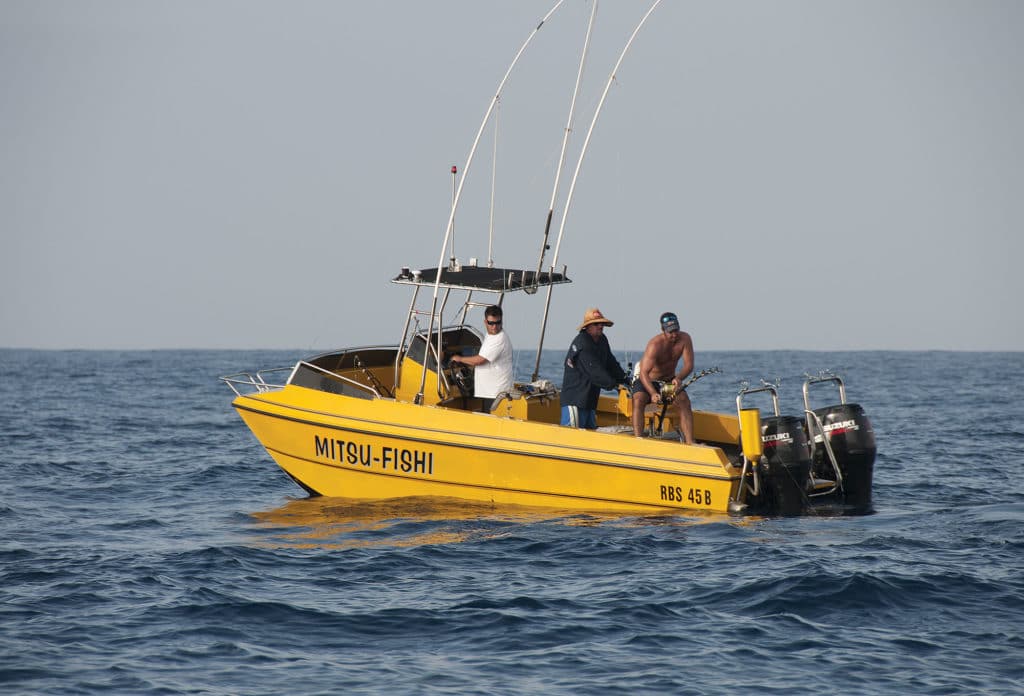
Longtime fisherman and Ski-Boat magazine publisher Erwin Bursik lived through the evolution of South Africa’s smaller, beach-launch craft, known as ski boats. In these notes, he described to me this most popular style of recreational-fishing vessel for the region:
“The offshore craft used in South African waters has a long history, adapting from a glorified paddle ski in the 1940s and early 1950s to the largely twin-outboard craft in use today. One of the primary criteria needed during this transition was the craft’s ability to be pushed into the surf off a beach, and then it had to be capable of turning very quickly before taking a breaker to get through the surf line and out to sea.
“As of the present, twin‑hulled, or catamaran-style, craft in the 14- to 20-foot class are being used in the above launch sites. Craft of similar design in the 18- to 30-foot class are being used from semiprotected launch sites as well as harbors. Cat-style hulls make up about 75 percent of the craft up to 30 feet and monohulls the remainder. In line with South Africa’s road-trailering regulations, most craft are less than 8½ feet in width.”
Beach Launch
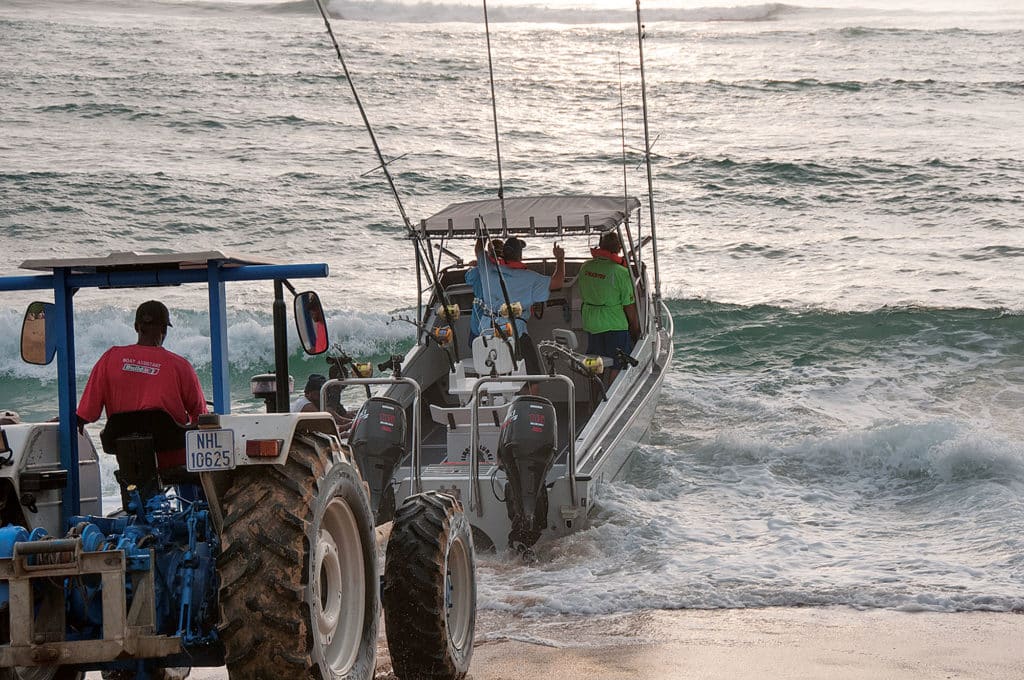
A 20-foot boat listed on the website for Z-Craft, a popular builder in the region, shows a hull weight of about 1,350 pounds and a draft measurement just shy of a foot. Boat reviews talk about a proud bow in and out of the water, boasting a very dry ride.
“Smaller craft are either built with forward-console or center-console configurations, whereas the bigger craft over 24 feet are generally forward consoles with enclosed cabins. The deck layouts are conveniently designed to ensure maximum fishability, and follow your American designs quite closely. Decks must be self-draining, of course, since they often take a wave during surf launches.”
Because of those wet conditions, ski boats often employ a false transom forward of the motors, which encloses the cockpit, Bursik says. Into that bulkhead, which some U.S. designs similarly feature, they install livewells and tuna tubes that they term “luna” tubes.
All Outboards
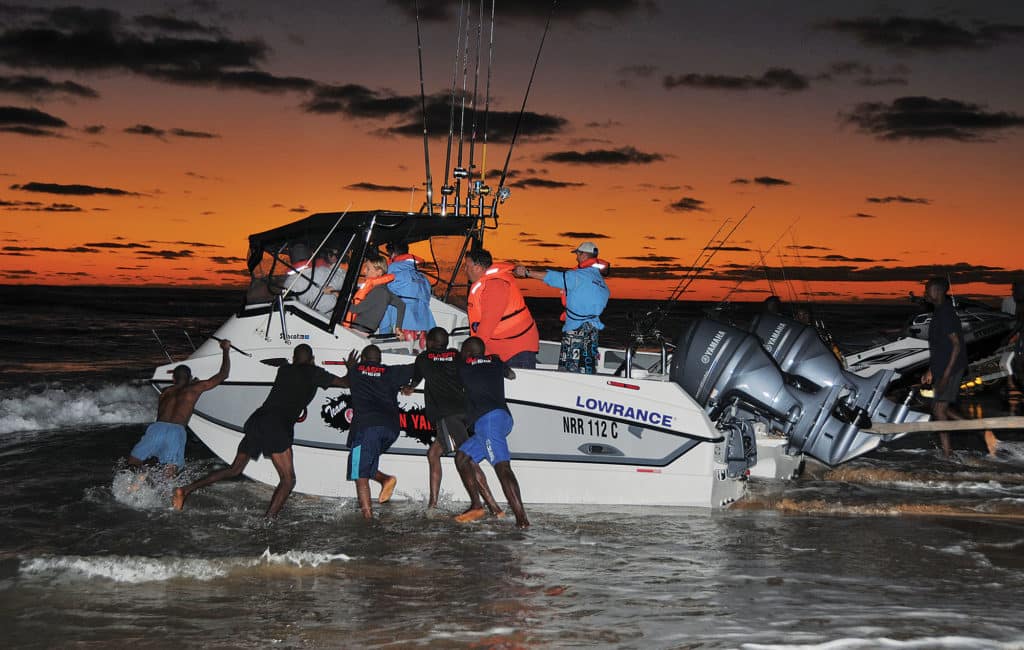
“Motors are 100 percent outboards for surf-launch boats and range from twin 40 hp to twin 200 hp outboards. Of the craft exiting harbors, the majority use outboards; some use Z-drives and shaft drives, but very few use IPS drives.”
To fuel these engines, about 80 percent of South African boaters use a series of 25-liter plastic containers stowed beneath the cockpit sole, rather than a built-in fuel tank. “Ninety percent of our launch sites are not marina or harbor related, and therefore fuel has to be carried over fair distances,” Bursik says. “It’s easier to do this in the containers than drag a boat long distances to fill directly into inboard tanks.”
Australian Hardtoppers
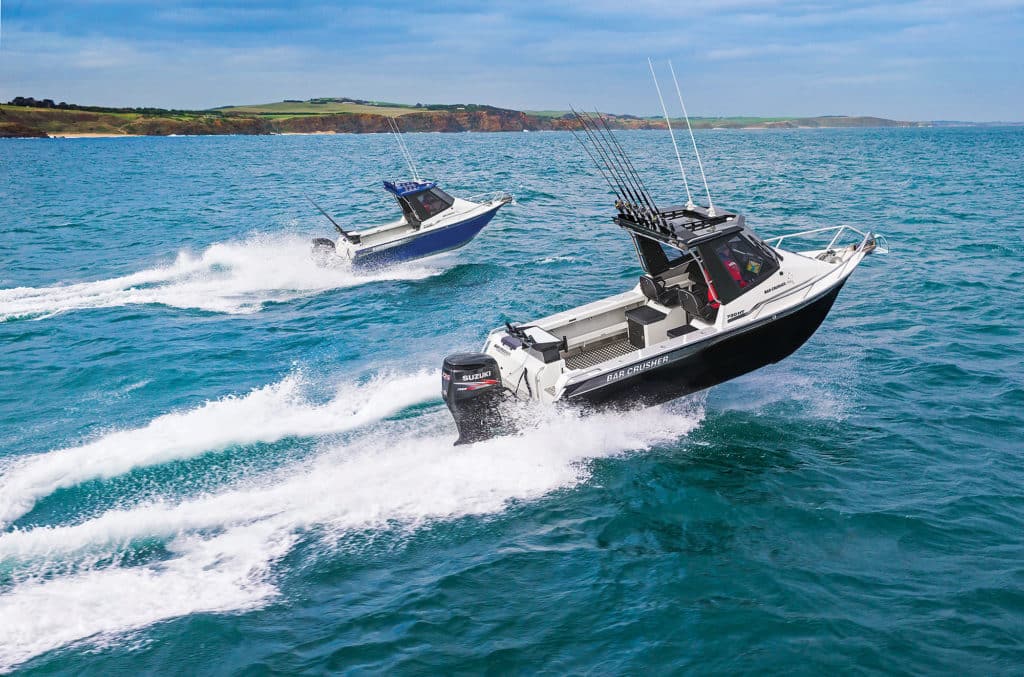
Although Bar Crusher builds boats from 16 to 26 feet in length with varying layouts, the Australian company says 22- to 24-foot hardtoppers probably prove most popular. Bar Crusher’s 670HT (22 feet) and 730HT (24 feet) hardtop aluminum monohulls rank high among buyers, and the 670HT was named Australia’s Greatest Boat by a group of national boating writers, Bar Crusher says.
Both boats feature a forward helm encapsulated on the front, top, and sides by metal and glass. The company says full pilothouse versions are available for some models, but this hardtop style protects anglers from spray and most rain.
Elemental Protection
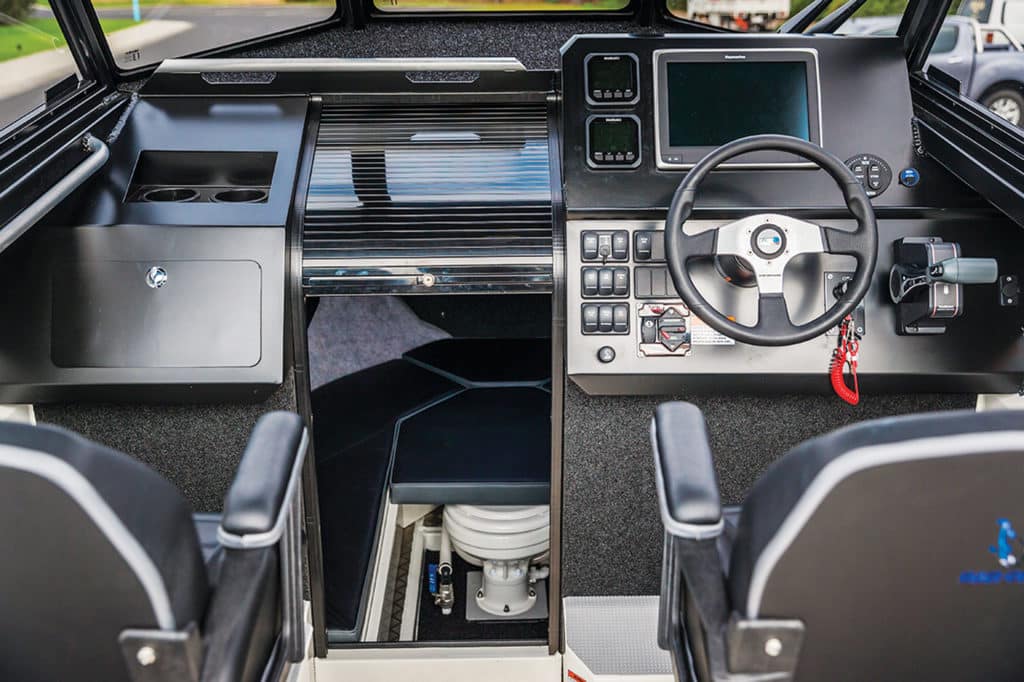
Australia’s metal boats date back about 70 years, Bar Crusher says, when anglers started experimenting with riveting thin-gauge aluminum to build small roof-topper dinghies called “tinnies.” Today, builders use welded seams, 4 and 5 mm aluminum plating, a subfloor frame similar to a fiberglass stringer system, and sometimes a bit of unusual new technology.
Bar Crushers feature what the company calls its exclusive Quickflow water-ballast technology, which stabilizes the boats at rest. The system utilizes a cavity that runs the full length of the keel and quickly fills with water when the boat is stationary. The weight of the water lowers the chines so it floats deeper for better stability. The water drains quickly as the boat moves forward.
Cockpit Amenities
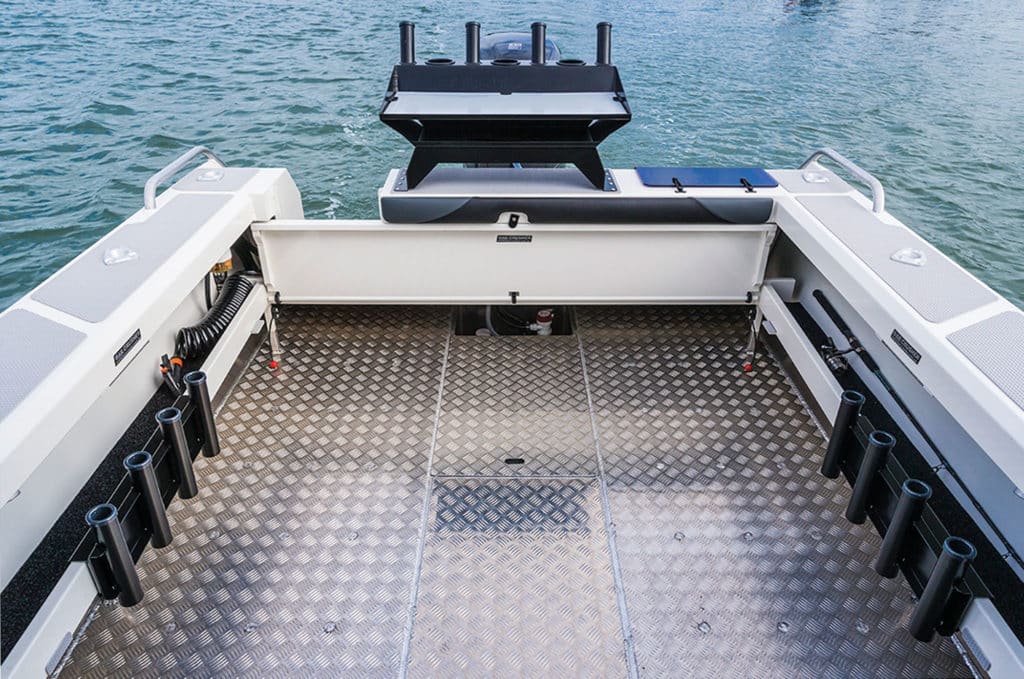
That technology likely comes in handy aboard these modern metal machines. With their slender beams — 7 feet 9 inches for the 22 and 8 feet for the 24 — these boats would naturally roll side to side a bit faster, though they should offer a better ride in rough seas (particularly with their 18- to 20-degree transom deadrise angles). Typical American fiberglass boats of this same size commonly carry 8½ feet of beam.
But Aussie anglers use these boats for everything from marlin and tuna fishing to barramundi at the river mouths, so a comfortable ride and stability become crucial.
Bar Crusher offers fishing features similar to our familiar packages: coaming around the cockpit, foldaway transom seat, step-through transom, and in-sole fish boxes. They also outfit fishing boats with livewells, a cutting board with a chum bucket, and plenty of rod holders.
United Kingdom Cats
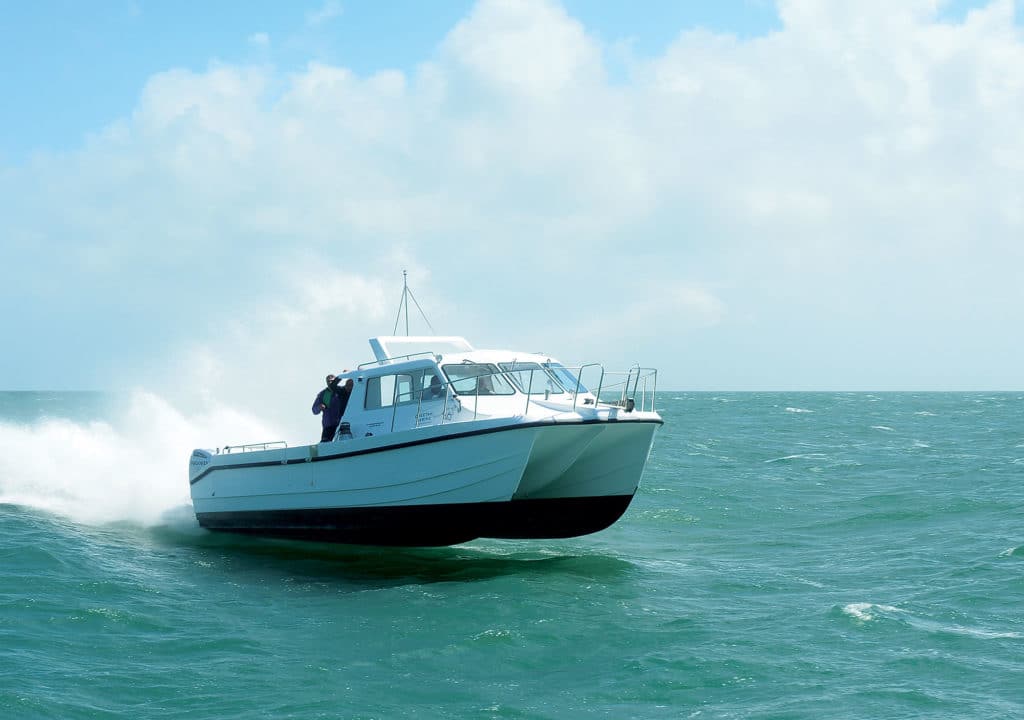
Frequent SF contributor Dave Lewis told me the following about his U.K. region’s small-boat evolution: “For many years, the charter fleet here in the U.K. consisted almost entirely of monohull single- or twin-inboard-diesel-engine boats licensed to take 10 to 12 anglers. In recent years there’s been a huge swing toward catamarans powered by twin outboards. Companies such as Isle of Wight-based Cheetah Marine have been at the forefront of this change.
“The leisure sport-fishing market has mostly been dominated by 16- to 19-foot trailerable boats, usually incorporating some form of open cuddy at the bow or a lockable cabin. Trailerable boats are still hugely popular, but many anglers now run 20- to 25-foot day cruisers they can keep berthed at a marina. Orkney Boats has long been at the forefront of the leisure side of the U.K. sport-fishing industry.”
I sent emails across the pond to Orkney and Cheetah. Cheetah responded, sharing information. In addition, the one U.K. boat I can claim any experience aboard was a Cheetah. As has become the trend, that outboard-powered fiberglass catamaran offered a very stable, comfortable ride in the nearly ever-present chop of the English Channel. Its generous cockpit easily accommodated a boatload of passengers.
Built to Order
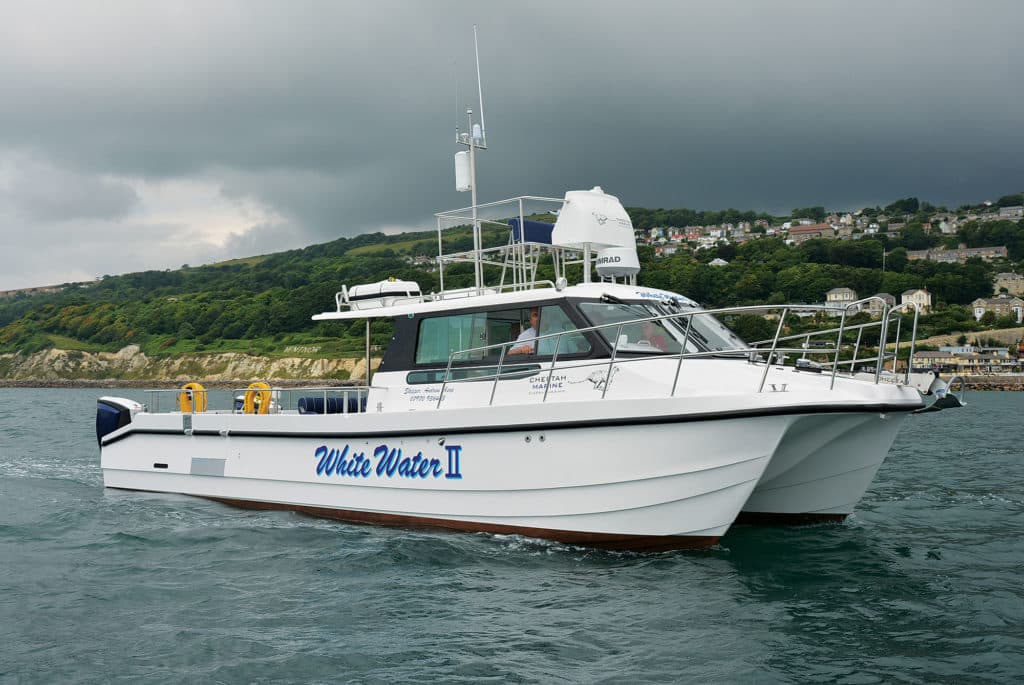
A commercial fisherman designed the first Cheetah cat after experiencing the limitations of launching and beaching a monohull in the surf. Today, the company builds each cat to order; its 10.2-meter (33½-foot LOA; 12-foot beam) twin-outboard-powered cat ranks as its most popular model. And while Cheetah builds a variety of custom deck designs and pilothouses, many anglers choose some kind of enclosure. Rarely do U.K. anglers enjoy true bluebird days, and the water temperatures remain cool year-round.
Fishing Options
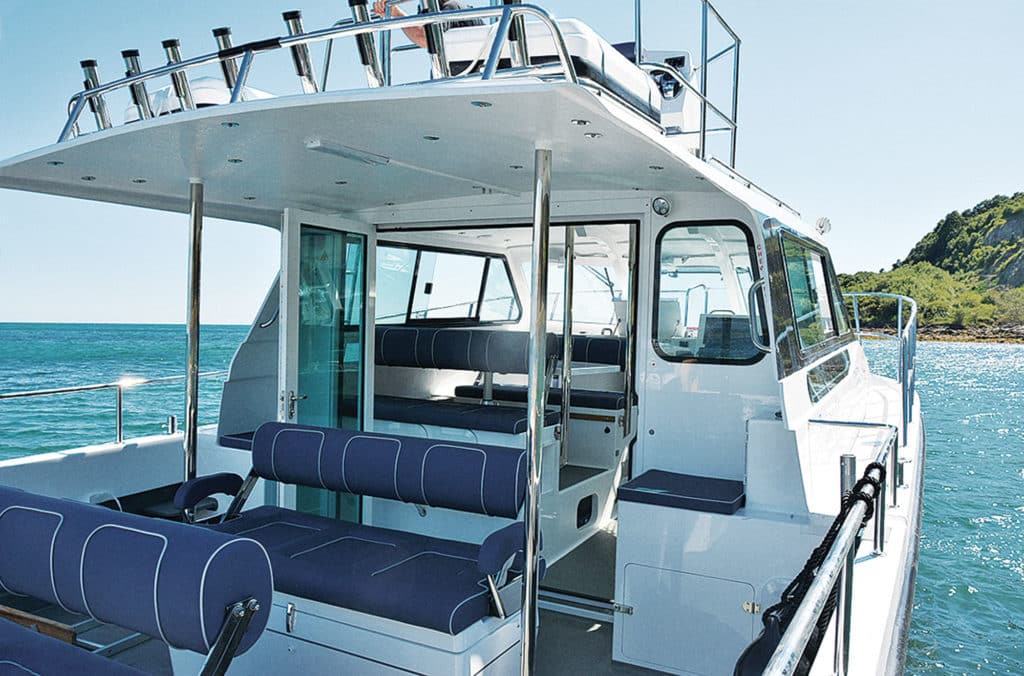
Anglers also choose options such as livewells, bait tables, rod holders and deck storage. An average package for the 10.2-meter model costs about $184,000 in U.S. dollars.
Cheetah cats feature semisymmetrical planing hulls. The lift created in the tunnel between sponsons and reduced hull resistance allow for the use of lower-powered outboards to achieve the same speed as a monohull, Cheetah says. In a country where gasoline prices hover around US$1.35 per liter — which works out to about $5.11 per gallon — fuel efficiency is paramount.
Pacific Northwest Dories and Aluminum Monohulls
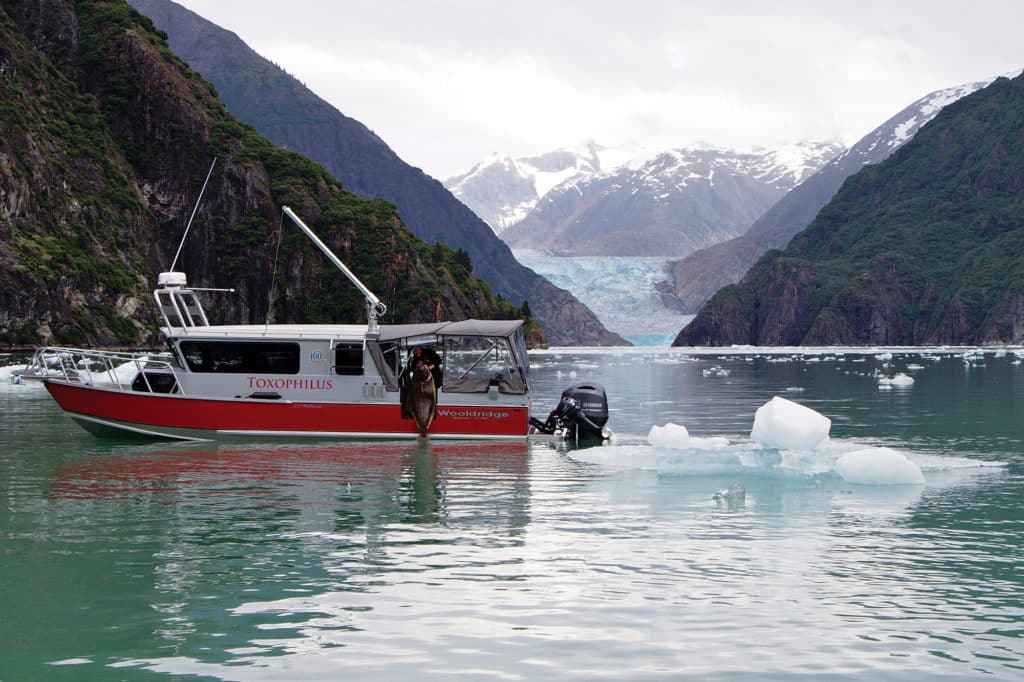
During the fishing trips I’ve taken to British Columbia and Alaska, I’ve always wondered why local anglers and captains seemed to prefer aluminum boats. Metal conducts heat better than other solids, so when the sun beats down, metal sizzles; and when icy ocean waters flow underfoot, brrrrr.
But the folks at Seattle’s Wooldridge Boats explained it this way: Aluminum boats are lighter, so fuel economy is better. A 23-foot Wooldridge Super Sport Offshore with a windshield weighs 1,720 pounds. A Mako 234 center console hull weighs 4,100 pounds.
People do a lot of exploring in the wild Northwest. With a metal hull, they can pull up on the rocky beaches to go clamming or hunting.
Aluminum Versus Fiberglass
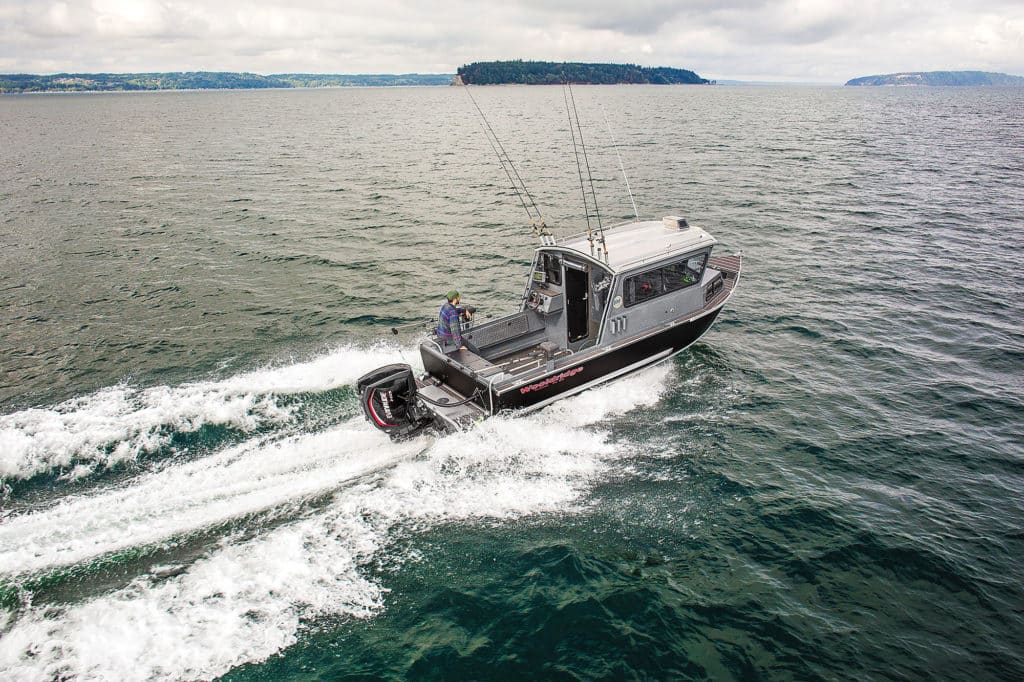
Aluminum builders have much more flexibility than fiberglass builders. “If our cabin is 6 feet 8 inches, and the buyer wants a cabin 3 inches taller, no problem,” says company vice president Grant Wooldridge, whose family has made boats for 101 years. “The big thing about aluminum too is that it doesn’t come out of a mold; that mold costs the glass builder a lot of money.”
Aluminum lasts a long time, providing it’s welded using 5000-series-grade marine aluminum, with the proper protective anodes and wiring. Wooldridge also believes in a strong undercarriage: He builds an impressive grid of welded-aluminum stringers below the deck.
Most Northwest anglers opt for a 26- to 29-foot boat with a pilothouse, warmed with a diesel heater, Wooldridge says. The metal boats carry one to two main outboards and usually a small kicker engine for slow trolling. Most anglers use dead bait, though with the revival of albacore tuna fishing closer to shore, Wooldridge says he’s installing built-in and aftermarket bait tanks into some boats. Many anglers also opt to use track systems to position downriggers in different locations along the gunwales. Rod holders are generally welded to the boat’s side rails.
Package prices start at about $95,000 for a 26-foot boat/motor/trailer and can reach into the $200,000 range for a fully equipped 29 package.
Wild Ride
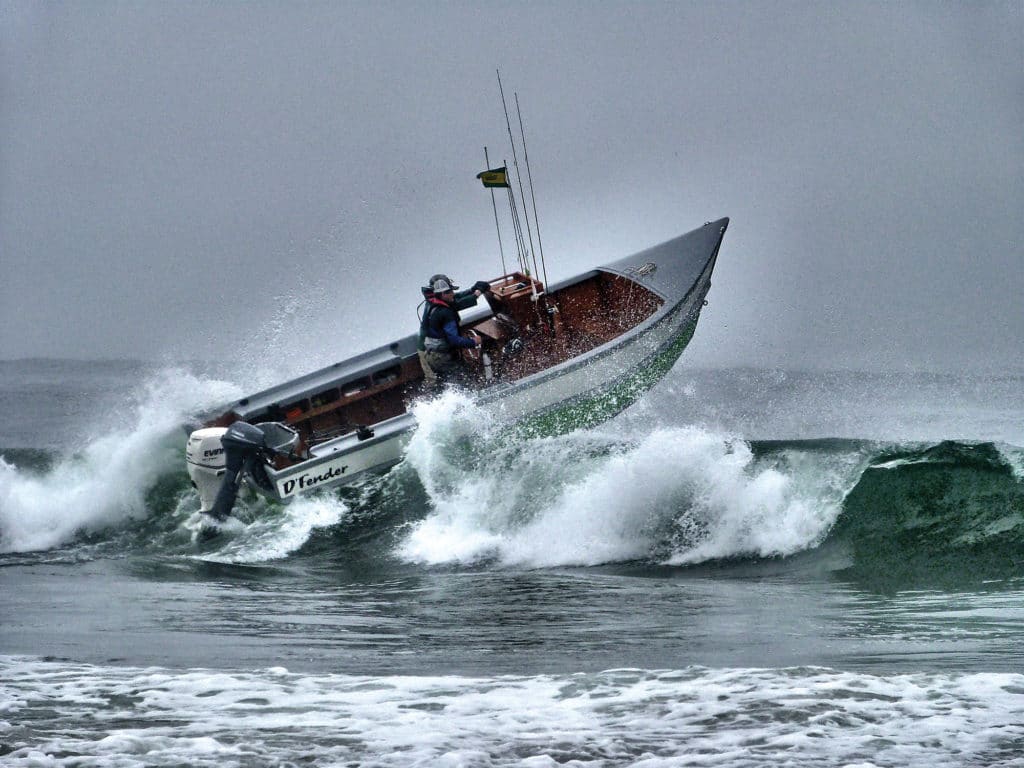
While Northwest anglers from Oregon to Alaska do prefer their aluminum monohulls, there’s a small group of diehard fishermen in Pacific City, Oregon, who are bound and determined to keep a century-old tradition alive: wooden-dory fishing.
These flat-bottom 20- to 22-foot boats launch from and land on the beach. Sandy Weedman, something of a visual historian for the dorymen, shoots some stunning images of dramatic exits and entries. The website for Pacific City Dorymen’s Association reveals about 300 dories call the town and its Cape Kiwanda home.
Hit the Beach
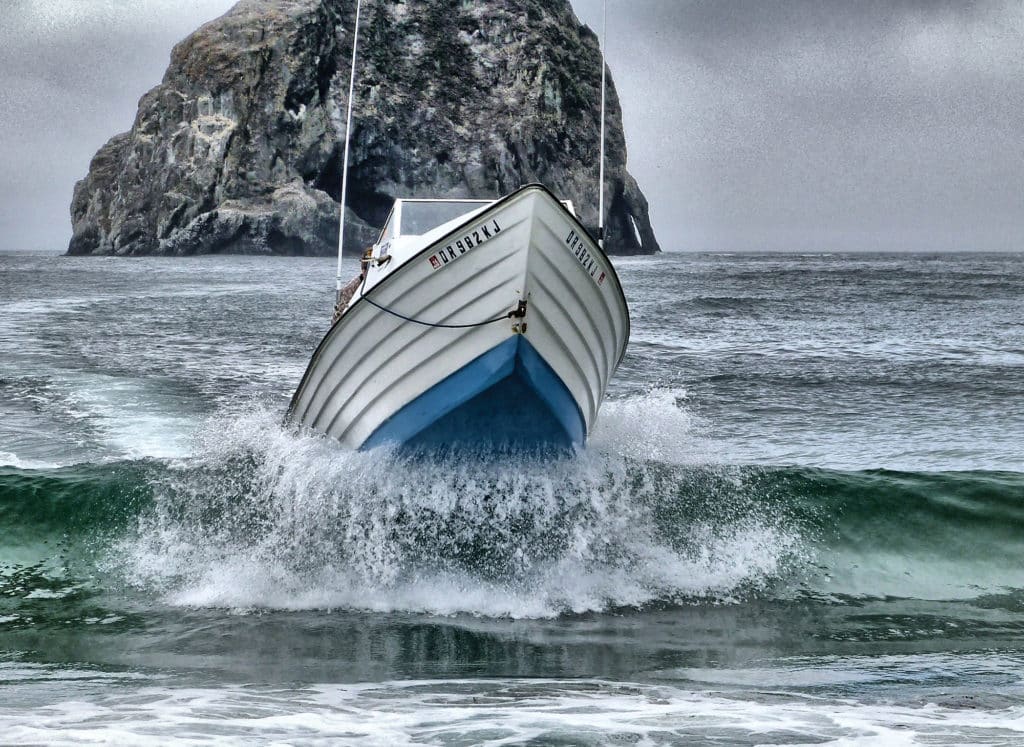
Longtime dory builders such as Terry Learned use Douglas fir marine plywood that’s custom-made at a regional mill, though some fiberglass dories exist. Wood fasteners include aeromarine epoxy and stainless-steel annular ring nails.
Learned and others make center consoles and cuddies with fish boxes, tackle trays and underbow storage, powered by outboard or inboard-outboard engines. Learned’s website suggests that the basic dory starts at $10,000.
South Texas Sleds
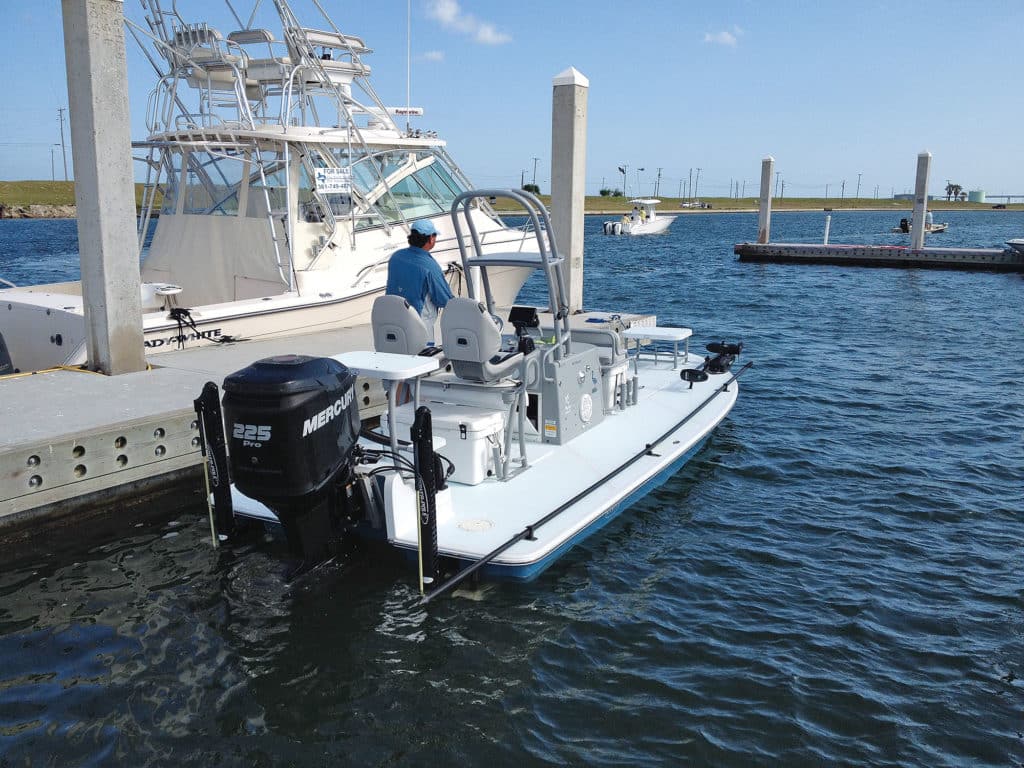
I stepped foot aboard a Texas tunnel-hull sled boat for the first time this past September. The 21-foot-8-inch NewWater Ibis carried an 8-foot-6-inch beam that lay flat as a pancake — a giant paddleboard. But wow, could this thing float shallow. (The specs say 5 inches with a Yamaha F200 and fuel.)
The low-freeboard “flush” deck offers many benefits, NewWater Boatworks says. It’s lighter, more spacious, self-bailing, easy to exit and re-enter when wade-fishing, and it creates less sail area so it won’t blow around on windy days, making it easier to pole.
Flat Flats Skiff
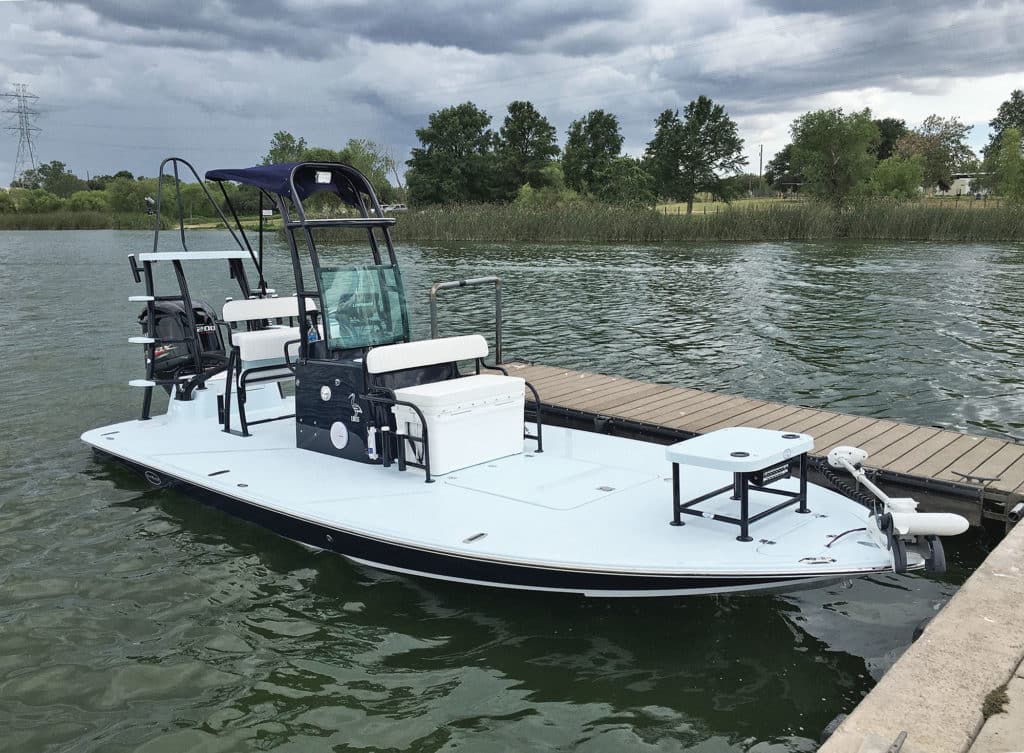
NewWater also says its Lamiflow TM tunnel design allows the prop to run above the hull bottom to avoid damaging grass flats. A patented technology called Lamivent lets you switch from tunnel to nontunnel performance — emptying the tunnel of water to increase speed — by flipping a switch.
The 980-pound Ibis also features a leaning post, a livewell, a small bit of storage, a poling platform, a bow platform and rod holders. What it gives up in creature comfort it gains in efficiency and fishability.
U.S. Boats Around the World
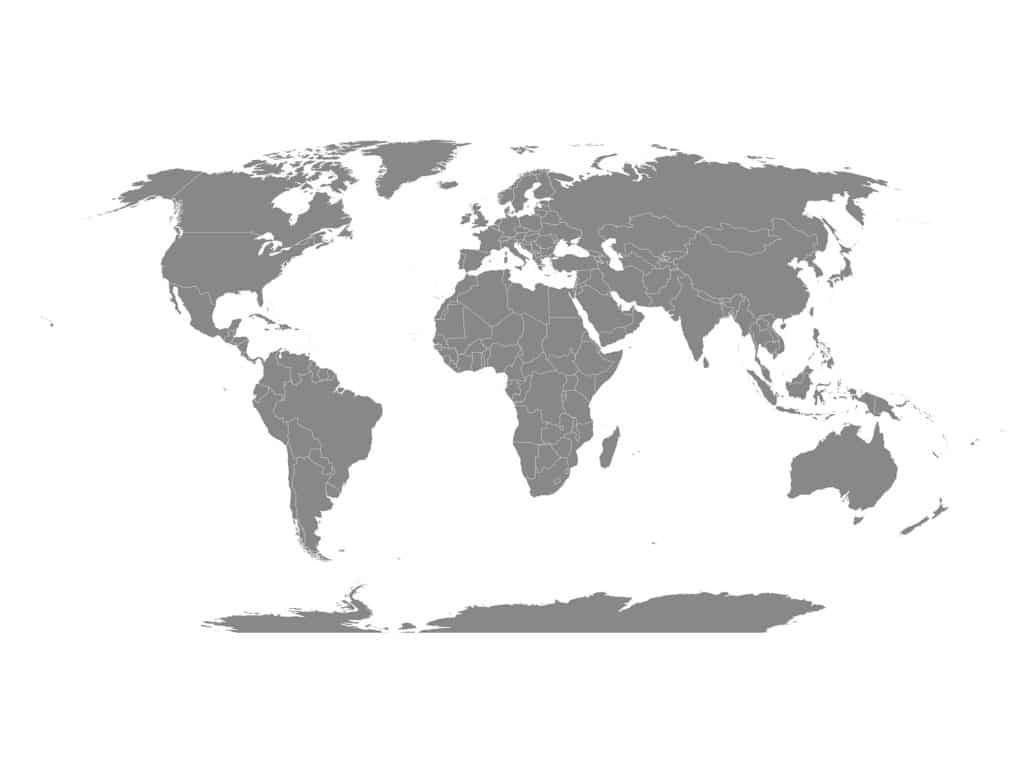
While boatbuilders worldwide develop designs uniquely suited to their locations, American manufacturers still hope to tap into buyers and markets outside the United States. In today’s global economy, that only makes good business sense.
“Once a company appreciates the importance of a healthy balance between domestic and international sales and they have established a productive dealer network, there’s no reason to go backward. It’s going to keep the company viable during the next economic downturn,” says Julie Balzano, export development director for the National Marine Manufacturers Association.
The NMMA works with American boatbuilders looking to export their products. The No. 1 market for American exports currently is Canada, with Western Europe, Mexico and Australia just behind. As a matter of fact, Mexico imports 100 percent of its recreational boats, Balzano says. “We also share a free-trade agreement.”
In other countries, such as Brazil, high tariffs on imported products ratchet up the price of American boats.
Builders that have notable presence in other countries? Balzano says Brunswick — with brands such as Boston Whaler, Sea Ray, Bayliner and Lund — tops the list. Others include Grady-White, Regulator, Scout, Contender and Wellcraft on the fish-boat side, and Regal, Monterey, Cobalt, Mastercraft and Chapparal on the pleasure-boat side.

